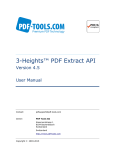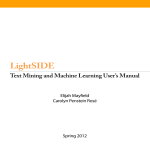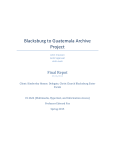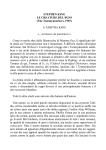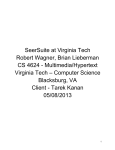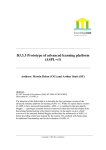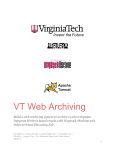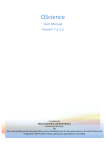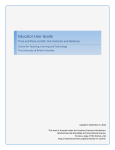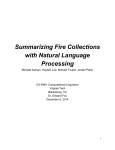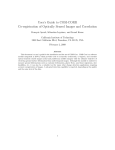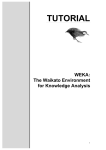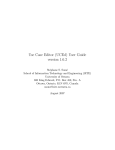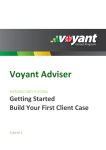Download News articles template summarization and categor
Transcript
News Summarization:
Building a Fusion (a Solr based system) special collection:
News articles template summarization and categorization
Souleiman Ayoub, Julia Freeman, Tarek Kanan, Edward Fox
Computer Science 4624, Spring 2015, Virginia Tech, Blacksburg, VA 24061
Email: {siayoub, juliaf, tarekk, fox}@vt.edu
March 15, 2015
Cover Page
1
Table of Contents
Cover Page ................................................................................................................................ 1
Table of Contents....................................................................................................................... 2
Table of Tables .......................................................................................................................... 3
Table of Figures ......................................................................................................................... 3
1.
Requirements ..................................................................................................................... 4
5.1.
Abstract ....................................................................................................................... 4
5.2.
Objective ...................................................................................................................... 4
5.3.
User Roles ................................................................................................................... 4
5.4.
Intent............................................................................................................................ 4
5.5.
Approach ..................................................................................................................... 5
5.6.
Milestones ................................................................................................................ 5
2.
User Manual ....................................................................................................................... 5
3.
Developer’s Manual ............................................................................................................ 5
4.
3.1.
Prerequisite Knowledge ............................................................................................... 5
3.2.
Collection ..................................................................................................................... 6
3.3.
NER ............................................................................................................................. 6
3.4.
Current Progress ......................................................................................................... 6
3.5.
Sketch of Application Process ...................................................................................... 7
3.6.
Possibilities for Future Program Use ............................................................................ 8
Design ................................................................................................................................ 8
4.1.
5.
Implementation ...........................................................................................................12
4..1.
Programming Languages ........................................................................................12
4..2.
Tools and Libraries Employed .................................................................................13
5.1.
Code Repository Plans ...............................................................................................13
5.1.
Phases........................................................................................................................14
4..1.
Text and Attribute Extraction ...................................................................................14
4..2.
Summarization ........................................................................................................14
4..3.
Indexing Documents ................................................................................................14
4..4.
Testing ....................................................................................................................14
Prototyping.........................................................................................................................15
5.1.
Classification with Weka .............................................................................................15
5.2.
Bringing it together ......................................................................................................16
2
5.3.
Fusion .........................................................................................................................17
6.
Testing ...............................................................................................................................18
7.
Timeline .............................................................................................................................18
8.
Lessons Learned ...............................................................................................................19
9.
Conclusion .........................................................................................................................19
10.
Acknowledgments ..........................................................................................................19
11.
References .....................................................................................................................20
Table of Tables
Table 1 - Categories .................................................................................................................15
Table 2 - Sample Header of Feature Set ...................................................................................15
Table 3 - Sample overview of features for Apple Review ..........................................................15
Table 4 - Average F1 Measure per Model .................................................................................15
Table of Figures
Figure 1 - Processing of the PDF news article through the application ....................................... 7
Figure 2 - Developer’s Data Flow ............................................................................................... 7
Figure 3 - Lucidworks Fusion capabilities and relations1 ............................................................ 8
Figure 4 - Solr interface used for querying. ................................................................................ 9
Figure 5 - Weka interface used for data mining. ........................................................................10
Figure 6 - Article view with “invisible” backend tags ..................................................................11
Figure 7 - From left to right this is the typical best run time speed of C#, Java, and Python ......12
Figure 8 - Security is a major issue for any project ....................................................................14
Figure 9 - Sample result of Summarized Article ........................................................................16
Figure 10 - Sample result of result in Fusion .............................................................................17
Figure 11 - Timeline of the implementation of the project ..........................................................18
3
1. Requirements
5.1. Abstract
This project will attempt to take Arabic PDF news articles and end with results from our new
program that index, categorize, and summarize them. We will fill out a template to summarize
news articles with predetermined attributes. These values will be extracted using named entities
recognizer (NER) which will recognize organizations and people, topic generation using an LDA
[1]
algorithm, and direct information extraction from news articles’ authors and dates. We will
use Fusion LucidWorks[4] (a Solr[5] based system) to help with the indexing of our data set and
provide an interface for the user to search and browse the articles with their summaries. Solr[5]
will be used for information retrieval. We hope to end with a program that enables end users to
sift through news articles quickly.
5.2. Objective
The summarized articles need to be archived in such a way that it can be retrieved to allow us
(and possibly future users) to use. With the use of Fusion, we can archive these information to
allow us to search and view the summarized articles. However, in order to achieve this, we’ll
need to collect the information that exists in the article via tools such as an NER, LDA and a
form of classification to determine subject (i.e. sport, politics, etc.) With these information, we
can use a template to help us summarize each articles.
5.3. User Roles
Each individual has a different role on the team. The two students currently taking the Hypertext
and Multimedia Capstone are Julia Freeman and Souleiman Ayoub. Julia Freeman will be a
developer as well as a peer evaluator. Souleiman Ayoub will also be a developer. Tarek Kan’an
will be a mentor and team leader.
5.4. Intent
By May 8, 2015 we hope to have an application that can:
1. Parse Arabic PDF[5] news sources and extract articles.
2. Obtain useful information from the parsed articles.
3. Use the extracted information to fill in empty templates, generating Arabic news article
summaries[7].
4. Enable the user to browse articles along with their summaries.
We will be using Weka[3] machine learning, Solr[5] retrieval system, Fusion[4], LDA’s [1], NER’s
[2]
, and Java to create, extract, and generate the final summaries and to provide the user the
ability to see the the articles and the summaries all in one place.
4
5.5. Approach
5.6. Milestones
● By February we will work on extracting the articles’ main attributes like categories,
Named Entities, and Topics; using machine learning tools, NERs[2], etc.
● By March we will learn Solr[5] and Fusion[4] and implement and modify Fusion schemas
to include extra fields.
● By April we will connect summarization results with Fusion[4] to enable automation.
Then we will validate the results of the programs and prepare a final report of what we
did, what we were successful with, and what we might not be able to complete.
● We reserve the entirety of May for final touchups, debugging, and user testing.
2. User Manual
There is currently no existing system for what we are attempting to do. We are piecing together a
few existing algorithms and methods for topic generating like LDA [1] (Latent Dirichlet
Allocation) and for named entity extraction like NER[2] (Named Entity Recognizer) but we have
to alter them to fit our project needs like handling the Arabic language which can be very
challenging. Hopefully in the future users will be able to see trends in news data which can help
with security or data mining.
3. Developer’s Manual
3.1. Prerequisite Knowledge
In order to use the software and modification needed to be made there are some prior knowledge
that is required in order to understand the scope of the application. Developer should be wellversed in a programming language (preferably Java and Python) and have at least a basic
understanding of natural language processing and machine learning in order to understand the
underlying concept used by the tools to help us achieve a solution. The following tools we have
used:
● Java (1.8 or greater) SDK from Oracle
● Python (3.x or greater) SDK from Python
● Weka (3.6.12 or greater) from University of Waikato
● RenA - Arabic NER (provided) from Souleiman Ayoub and Tarek Kanan
● ALDA - Arabic Latent Dirichlet Allocation (provided) from Souleiman Ayoub and Tarek
Kanan
● Fusion from LucidWorks
5
3.2. Collection
We will also be providing the collection of roughly 120,000 articles which will can be used to
alter, modify or append to if necessary depending on end-goal. These articles are encoded in
UTF-8 and should be processed using UTF-8 Encoding/Decoding, most languages such as Java
and Python provides support (BufferedReader[8] Java API and codecs[9] Python API for more
info). The use of the following tools NER, LDA and classification will be used to help us
generate a summary to provided in the fusion schema along with the article. Each of these
articles will be classified using Weka, more explanation will be provided below.
3.3. NER
There are two ways to use the NER, we have provided a python script that will quickly generate
named entity extraction if needed for testing purpose, the python script is called ner.py and can
be used as follows:
> ner.py -F <text_file> -t=<[PERS,LOC,ORG]> > <output>
The command above will generate a text file which consists of named entities based on the given
file. -t are the named entity given to extract.
However, for a more advanced extraction, such as n-gram solution and advanced structures.
Please refer to the class arabic.ner.RenA which consists of the option to request more features.
3.4. Current Progress
We are currently trying to perfect a way to parse text documents into ARFFs (Attribute-Relation
Files) that will be used as input to the machine learning program. This type of document (ARFF)
is ideal for the project because we can more easily scan the document, categorize, and
summarize it as opposed to creating a whole other program to parse text documents. The
conversion is not perfected yet because some articles might only contain pictures which are of no
use to the program. We also remove any stop words which are words which are placeholders like
“the” or “a” but in Arabic. This means we will have to go through and remove any empty files
after they have been converted. To ensure that we are creating ARFFs properly and they are
categorized properly (ex., a soccer article is not put into the Art category) we will have to
manually test a sample of the data to make sure that it works for the entirety of the data set.
6
3.5. Sketch of Application Process
PDF
Raw Text
CSV (Feature
set)
CSV on
Collection
Classification
Figure 1 - Processing of the PDF news article through the application
Information
Extraction
Build Corpus
Generate
Summaries
Index Collection
with Fusion
Fusion Search
Results
Figure 2 - Developer’s Data Flow
7
3.6. Possibilities for Future Program Use
We are only planning to implement this program for the Arabic language. We hope that the work
can be extended for use with more languages in the future. We are working with Arabic which
means the code we write has to be language independent because some of the programmers do
not speak or read Arabic. Optimistically countries like France or Australia that are trying to
analyze news related issues could sort through news articles under a certain category and then
use the information as meta data. It also helps that this is a scholastically created project so there
are no monetary sponsors that could influence the creation of the project. News in America is
notoriously bi-partisan and hopefully this will be a way to view news trends without trying to
sway the end user to a particular viewpoint (more specifically the viewpoint of the sponsor). It is
also beneficial that we are using Java as a language to create the program because it is one of the
most widely used programming languages in the technical community.
4. Design
We are using Lucidworks Fusion for this program. It has a lot of capabilities that we are using, mainly for
indexing.
Figure 3 - Lucidworks Fusion capabilities and relations
1
Fusion is built off of the Solr Apache system. We use Solr for querying after we have indexed the news
items.
8
Figure 4 - Solr interface used for querying.
We are also use Weka for data classification. It was developed by the university of Waikato
9
Figure 5 - Weka interface used for data mining.
The user will have an article view, and their will exist tags for every article that the user will not be able
to see but will allow the article to be categorized.
10
Figure 6 - Article view with “invisible” backend tags
11
4.1. Implementation
4..1. Programming Languages
Java is the only programming language used in this project. We chose this language over other
prevalent languages like C or Python for a couple of reasons. C takes more time to type because
the programmer must directly allocate any memory used for the project, but this means that it
will hopefully be faster and more efficient because the user manages all the memory. A large
potential problem using C is memory leaks, if the developer did not program the application
correctly. This means that the application will not reuse allocated memory and can eventually
run out of usable memory. Python is typically easier to write than Java, but this tradeoff means
that will it will most likely run slower than its Java counterpart 10. Java seemed to be a good
middle ground for ease of writing the code and the speed which it will run. It also helped that the
developers have many years of experience writing in Java compared to any other language. The
running speed of a program might not be an issue for smaller projects because there is less of a
time difference, but if someone chooses to expand upon this project in the future we would like
to enable them to make significant changes.
Figure 7 - From left to right this is the typical best run time speed of C#, Java, and Python
Java is platform independent which can be useful for others using or programming this project.
Unfortunately, compared to other languages, programmers are encouraged to use Object
Oriented Programming when writing in Java which can take more time to write. However, it will
be much easier for future developers to understand what is going on in the code and to work on it
immediately.
12
4..2. Tools and Libraries Employed
We have already introduced the tools we will be using, Weka, Solr, and Fusion. They are all Java
based which is complementary to us programming in Java. Tools that are Java based are were
written and created using Java.
Since we are using Java we will limit ourselves to using the built in libraries Java provides.
5.1. Code Repository Plans
We will not be using a program to manage commits. There are a limited number of personnel
working on this project so there is little likelihood that multiple people will attempt to write code
at the same time. Every person is working on different parts of the project so even if people are
working on the project at the same time, there is no chance that someone will overwrite another
member's work, or that their code will be impacted by code updates. Since this is not a massive
project in regards to the number of people working on it we will only host on local machines,
and every individual will have their own local copy of code. The final results of the program will
be stored on a separate server.
We do not need to worry about many security issues for the project. The largest problem we
could encounter is a user accidentally or intentionally interacting with the source code for how
the program works. Since the project will be stored locally the user who changed the code will
not impact any other users eliminating the need for login credentials. The server should handle
any unauthorized accesses or changes, eliminating the responsibility of security for our program.
Security is normally a major issue, but this program will not contain any sensitive data nor will it
register users who use it so there is no need to worry about security.
13
Figure 8 - Security is a major issue for any project
5.1. Phases
4..1. Text and Attribute Extraction
We need to write algorithms to extract the text and any relevant attributes to be able to categorize
articles. All other summarization goals are dependent on finishing this phase.
4..2. Summarization
We will provide a brief summary for each article so that if the title is not adequate for a user they
will be able to read the summary as well. We will alter the Fusion template to allow the summary
to appear on the same page as the article title and category.
4..3. Indexing Documents
We will create a way of sorting and identifying the documents so that we can access them in a
manner of our choosing.
4..4. Testing
This phase will require many hours of manual testing to ensure that the algorithms work
correctly. We will also step through the program to ensure that it is reacting correctly and meets
all of our project specifications.
14
5. Prototyping
5.1. Classification with Weka
In order to fully utilize implementation of fusion, we need to begin by classifying the news
articles for the purposes of generating summarization for each article based on its categories.
Each file must consists on of the following category as show in the table below:
Table 1 - Categories
Art
Economy
Politics
Social/Society
Sports
In order to classify the collection of articles, we need to choose a random sample to build our feature set.
We are given a random sample (Thanks to Tarek) of 2,000 articles, where each categories consists of 400
articles. In order to build our feature set, we will first need to collect featured words (or bag of words)
from all of the articles, (unique words, and elimination of stopwords). An example can be seen in the
table below:
Table 2 - Sample Header of Feature Set
id
label
Apple
Car
Phone
Computers
Languages
Java
Suppose our training set consists of articles regarding to technology, we know that each article has a
specific label, such that for each words in the article, if it triggers a word that exists in the feature said, a
boolean will be placed in the cell in respect to the word. For example, in the table below, continueing
from table 2, suppose we have an article about an Apple product review. It is expected that Apple, Phone
and perhaps computer will have a boolean flag. (Suppose we have a technology category)
Table 3 - Sample overview of features for Apple Review
id
label
apple_review technology
Apple
1
Car
0
Phone
1
Computers
1
Languages
0
Java
0
As we continue to do this for the 2,000 articles with it’s appropriate label, we can begin to train using
various classification models, including SMO (SVM), NaïveBayes, and Random Forest, each using 10fold cross-validation.
Table 4 - Average F1 Measure per Model
SMO
84.38%
NaïveBayes
79.31%
Random Forest
77.17%
15
We have opted to use SMO as it provided higher results for classifying labels correctly. After confirming
the selection of our model. We can now begin to classify our dataset of ~120,000 articles using SMO.
However, as previously stated, we need to extract out bag of words from each articles and flag the
booleans to begin classification. Once all the articles have been labeled, we’ll begin to put together the
results to form a summary of the article.
5.2. Bringing it together
For each, article we are given a CSV file that contains the category, as well as other information
that has been extracted using NER to collect entities, LDA to collect articles topics, titles, and
author. Below is a screenshot of a sample file meeting these criteria.
Figure 9 - Sample result of Summarized Article
16
5.3. Fusion
Once we have collected our summaries for our articles. We can beging importing them to
Fusion. Fusion has a very simple UI that allows us to import a persistence and it will
automatically index the article on it’s own. After importing our local persistence to fusion, we
can begin searching; below we can see some sample result:
Figure 10 - Sample result of result in Fusion
We have modified the schema to allow adding and removing some fields by adding an extra
field of summary and removing unnecessary field such as source link. We have also helped test
the new interface for Fusion.
17
6. Testing
We have done various form of testing to help ensure stability of our application. For functional
testing, we have tested the schema file modification and extracting the text files to XML file. we
also did a functional and unit testing for indexing to make sure that everything searches
properly. We have done majority of our integration and usability testing on our interface to make
sure that everything integrates well and is approachable.
7. Timeline
The team plans to work on the project consistently until the end of the semester in May 2015.
We will meet every Wednesday afternoon for two hours in Torgeson to discussed reviewed work
and to continue developing the project. We are using an Agile program development style where
we continually change and update the project to fit any problems, design needs, or deadlines.
This is necessary with our continual feedback from the professor and client. If we were to use a
Waterfall style method we might not be able to use our client’s and professor's feedback. This
style is very sequential and once we finish a portion of the project we cannot make any changes
later on. We have already outlined our proposed timeline on how we plan to complete this
project in time.
Figure 11 - Timeline of the implementation of the project
The developers will learn Solr and Fusion by reading the companies’ websites. Afterwards, we
will then try to make small programs using what we learned. At a point where we are
comfortable using this technology we will implement these tools in our project. Fusion has a
predefined template, which we will need to modify to allow us to include extra fields. To do this
efficiently we will need to understand the underlying architecture driving this tool. March
requires us to classify news articles so we can determine which algorithm will be most accurate
18
to minimize any categorization issues. We will be displaying a summary along with the
classification results, which will require more Solr and Fusion manipulation. Result validation
will take a large amount of time since we currently do not have any computer related automation.
This means developers will manually sift through a sample of the data. It will be immediately
apparent if the summarization and categorization categories display properly so there will be no
need for further testing.
8. Lessons Learned
So far we have been able to keep to the timeline. All work that our contract stated which had to
be finished by May is complete. We encountered various problems developing this system. A
student who was supposed to help develop tags was unable to aid us. Team members also
became sick which meant that some of the team meetings had to be held online. To keep to the
timeline the team worked extra to cover any deficits in other people’s work. Even though a
student was unable to help us with some work we still kept to the schedule. The timeline states
the work we have left, integrate Fusion summarizations and debug the project.
9. Conclusion
We have gotten everything together and working smoothly as per requested from the client. The
result are as expected. The interface runs seamlessly and shows the results based on the search
criteria. The application is up an running on the clients machine and has been tested. The
documents that were parsed have been imported into Fusion and indexed, along with the
modified schema file which should now show the results of the extra fields.
10. Acknowledgments
We would like to acknowledge Dr. Edward Fox, the class professor, for his guidance throughout
the class. We also would like to thank our client and mentor Tarek Kanan for all his help the
creation of this project. He can be reached at [email protected]. A special thanks goes to
Lucidworks, the Fusion creator company, for answering some of our questions and for guiding
us through the Fusion part of this work. This work was made possible by NPRP grant # 4-029-1007 from the Qatar National Research Fund (a member of Qatar Foundation).
19
11. References
[1] LDA http://en.wikipedia.org/wiki/Latent_Dirichlet_allocation
[2] NER http://en.wikipedia.org/wiki/Named-entity_recognition
[3] Weka http://www.cs.waikato.ac.nz/ml/weka/
[4] LucidWorks Fusion http://lucidworks.com/product/fusion/
[5] Solr https://wiki.apache.org/solr/
[6] PDF Parsing http://www.pdfparser.org/
[7] Text Summarization http://en.wikipedia.org/wiki/Automatic_summarization
[8] Java BufferedReader http://docs.oracle.com/javase/8/docs/api/java/io/BufferedReader.html
[9] Python Codecs https://docs.python.org/3/library/codecs.html
[10] https://www.python.org/doc/essays/comparisons/
Resources used:
http://home.adelphi.edu/~siegfried/cs480/ReqsDoc.pdf
http://wwwis.win.tue.nl/2R690/projects/spingrid/srd.pdf
Figures:
1
http://image.slidesharecdn.com/meetsolrforthefirsttimeagain-141013005741-conversiongate02/95/meet-solr-for-the-tirst-again-18-638.jpg?cb=1413179929
2
http://heliosearch.org/wp-content/uploads/2012/08/solr_admin.png
3
http://www.ibm.com/developerworks/library/os-weka2/weka-data5.jpg
8
https://users.soe.ucsc.edu/~kunqian/logos/csharp.png
https://lh4.googleusercontent.com/0fbEaUy0zgs/Uycq_aNlvHI/AAAAAAAAG5s/vvq4LmANws0/s0/
java-logo.png
http://www.blancocuaresma.com/s/static/images/python-logo.png
9
http://www.valiantsolutions.com/images/infosec.jpg
20




















